|
|
 |
|
June 28, 2012
I am very fond of both whisky and whiskey. I like vodka, icy and unadulterated, when caviar is being served (as if that ever happens in my life), but otherwise I agree with Eric Asimov’s musings in a recent New York Times article: “What? No flavor?” he wrote, “No aroma? No character? Well, that’s vodka for you: A bland, neutral cipher.”
Like Asimov, what I really love is gin, especially on these warm, summery evenings. The world’s most refreshing and festive beverage may well be gin and tonic, though my go-to cocktail is gin rickey (gin, club soda, fresh lime). Of course I’m also partial to a good martini, though only one per evening since I’m mindful of Dorothy Parker’s self-imposed one-martini-only rule. “Two at the very most,” she insisted, “Three I’m under the table/Four I’m under the host.”
In addition to just plain liking the taste of gin, I appreciate it for the salubrious effect it has on me. I know this isn’t the case for everyone, but in my experience a gin-based cocktail is not only invigorating at the end of a long day, it also invariably soothes random aches and pains when necessary. Perhaps it’s the botanicals, notably the juniper berries (the Greeks and Romans apparently distilled juniper berries for medicinal purposes). Angelica, another commonly used botanical in gin, is said to ease certain symptoms associated with colds and arthritis.
My friend Rebecca believes that gin has helped offset the seasickness she occasionally experiences when sailing. I would not recommend drinking gin to anyone else for any purpose  other than pleasurable imbibing, but since Rebecca is about to embark on a summer-long sailing expedition up the Atlantic coast, I decided to create a gin based cocktail for her. In case the gin turns out not to be a fail proof antidote to seasickness, I’ve also included ginger, which is said to ward off nausea. For dash of extra flavor there’s the addition of bitters, widely considered to be good for the digestive tract. For the mixer I recommend either ginger ale, a popular home remedy for indigestion or motion sickness, or ginger beer, which I favor for its more intense flavor, and also because it is slightly less carbonated and notably less sweet. other than pleasurable imbibing, but since Rebecca is about to embark on a summer-long sailing expedition up the Atlantic coast, I decided to create a gin based cocktail for her. In case the gin turns out not to be a fail proof antidote to seasickness, I’ve also included ginger, which is said to ward off nausea. For dash of extra flavor there’s the addition of bitters, widely considered to be good for the digestive tract. For the mixer I recommend either ginger ale, a popular home remedy for indigestion or motion sickness, or ginger beer, which I favor for its more intense flavor, and also because it is slightly less carbonated and notably less sweet.
Since a small sailboat doesn’t have extra space for multiple bottles of booze and all the trappings that modern cocktails seem to call for, one of my goals was to keep the recipe simple, with no more than two or three additional ingredients besides the essential gin. The drink can be made in a highball glass, but for summer sailing it’s more refreshing served in a tall glass.
What have I named my concoction? Why, Gin-Gin of course.
GIN-GIN
1 piece of candied ginger
2 ounces gin
2-3 dashes Angostura or other bitters
8 ounces ginger ale or ginger beer
Rub the rim of a tall glass with the candied ginger, then drop the ginger into the bottom of the glass. Shake in the bitters and pour in the gin. Muddle the ginger around a little if you feel like it, then add ice cubes. Fill the glass with ginger ale or ginger beer. Tchin-tchin.
Posted by Marguerite Thomas at 11:38 AM
|
|
June 20, 2012
You may have heard of the Judgment of Paris, the 1976 wine tasting that pitted handpicked wines from California against many of the finest and most expensive wines produced in France. In a shocking development, a panel of French wine judges preferred the California wines over those hallowed wines from France.
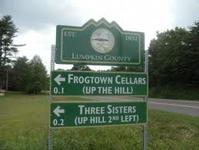 A cabernet sauvignon from Stag's Leap Wine Cellars and a chardonnay from Chateau Montelena, both wineries of the Napa Valley, prevailed over the premier cru and grand cru wines from Bordeaux and Burgundy. The wines had been tasted blind, with the judges having no knowledge of each wine's origin or pedigree. A cabernet sauvignon from Stag's Leap Wine Cellars and a chardonnay from Chateau Montelena, both wineries of the Napa Valley, prevailed over the premier cru and grand cru wines from Bordeaux and Burgundy. The wines had been tasted blind, with the judges having no knowledge of each wine's origin or pedigree.
The universe of fine wine appreciation was stunned, and the results propelled the Napa Valley and the California wine industry to the position of unparalleled prestige it enjoys in the U.S. to this day.
More recently, we have the Judgment of Princeton, a blind tasting earlier this month modeled closely after the infamous 1976 tasting in Paris. At the Judgment of Princeton, the likes of Chateau Mouton Rothschild (Bordeaux) and Joseph Drouhin Clos des Mouches (Burgundy) were up against red and white wines from New Jersey.
The French wines prevailed at Princeton, but the vote was close. Eyebrows were raised, particularly at the erudite magazine The New Yorker, which headlined its coverage, "Does all wine taste the same?"
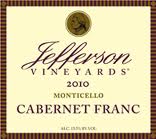 For what it's worth, I'm hardly surprised that New Jersey's Heritage BDX and Unionville Single Vineyard came close to knocking off the French. And not because I think the tastings or the tasters may have been flawed, or that all wines taste the same. What we are witnessing, I believe, is the emergence of very fine American wine in places we never would have dreamed in the not too distant past. For what it's worth, I'm hardly surprised that New Jersey's Heritage BDX and Unionville Single Vineyard came close to knocking off the French. And not because I think the tastings or the tasters may have been flawed, or that all wines taste the same. What we are witnessing, I believe, is the emergence of very fine American wine in places we never would have dreamed in the not too distant past.
I admit I am a recent convert to that position. I once was of the opinion that those intrepid souls making wine in the hinterlands were either quixotic figures hopelessly tilting at windmills or foolish cranks attempting to prove the unprovable.
Then I got religion. Through my position as director of several major wine competitions, I had a chance to taste the remarkable wines from Frogtown Cellars, of Lumpkin County, Ga. They are serious wines made from grapes that historically did well in France. Georgia to me meant sweltering heat and humidity in summer. I couldn't imagine fine wine from such a place.
Frogtown started entering the wine competitions and consistently won medals in blind tastings. I spoke to the winemaker, Craig Kritzer, and learned that vineyards are thriving in the foothills of the Appalachian mountains, that it's not as warm and muggy as, say, Atlanta or Savannah, and he truly believes his wines can stand up to the best in the world.
Now when Frogtown wins another impressive medal, I merely yawn. And smile. Kritzer is a serious winemaker and a true visionary.
Then there is Andy Reagan, the winemaker and general manager at Jefferson Vineyards in Monticello, Va. Every year Reagan sends his top wines — a cabernet Franc, a red Bordeaux-style blend and a viognier — to the various competitions I run, and every year they reap important awards for Virginia wine.
What's more, one of his neighbors — Barboursville Vineyards — is a worthy rival in the cabernet franc category, and also produces perhaps the finest nebbiolo (the grape of Barolo and Barbaresco) in North America.
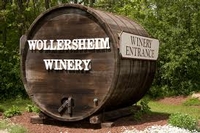 From the Midwest, I can't be anything but impressed with the St. James Winery of St. James, Mo. Using French hybrid grapes such as seyval, St. James produces impeccable wines and routinely racks up a dozen or more medals at each competition it enters. And this year at the San Diego International Wine Competition, the Wollersheim Winery of Prairie du Sac, Wis., had six Platinum-award wines and was named winery of the year. From the Midwest, I can't be anything but impressed with the St. James Winery of St. James, Mo. Using French hybrid grapes such as seyval, St. James produces impeccable wines and routinely racks up a dozen or more medals at each competition it enters. And this year at the San Diego International Wine Competition, the Wollersheim Winery of Prairie du Sac, Wis., had six Platinum-award wines and was named winery of the year.
Over the years, I've also tasted gorgeous wines from South Dakota, Colorado, New York, Pennsylvania, Rhode Island, North Carolina, Texas and Michigan — even New Jersey.
The fine-wine map has changed. Maybe you can't afford the best French wine money can buy. No worries. Just look around you. Made in the U.S.A. isn't such a bad thing in the universe of good wine.
Posted by Robert Whitley at 10:50 AM
|
|
June 6, 2012
Yes, I know it’s possible to get a bad meal in Paris, but my husband and I just returned from the City of Light where we enjoyed one exciting, beautifully prepared and delicious dish after another during our all-too-brief visit there. We deliberately chose to eat in non-Michelin starred, moderately priced restaurants, and not one of them disappointed us (of course nothing is truly “moderately priced” in Paris--or, for that matter, anyplace else we’ve been recently). I thought I’d share some of our dining highlights, which you might find useful if you’re planning a visit to Paris in the near future.
For our first dinner we’d made a reservation in the Marais, at Café des Musées. This small restaurant, a couple of blocks from the magnificent Place des Vosges, looks exactly like the 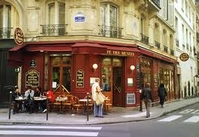 sort of place you envision as soon as you hear the words “Parisian Café.” Its traditional ambience is one reason we return to it every time we’re here, but the main draw is its straightforward soul-satisfying fare. sort of place you envision as soon as you hear the words “Parisian Café.” Its traditional ambience is one reason we return to it every time we’re here, but the main draw is its straightforward soul-satisfying fare.
Despite suffering from slight jet-lag bleariness and transatlantic travel fatigue, I was very clear minded about what I wanted to eat at Café des Musées: Asparagus! What springtime in France means to me is plump, sweet, tender stalks of white asparagus, a rare treat almost unknown at home. I’ve got nothing against the thin green stalks that are ubiquitous in the USA, but I’ve never understood why the far superior white asparagus beloved by Europeans has never caught on with my fellow Americans. At Café des Musées the cool, pale spears--white edging towards violet--were bathed in a creamy sauce that had been spiked with Chartreuse and further enhanced by the addition of finely minced fresh tarragon. The rest of my body may have been tired but my taste buds fairly jumped up and down with excitement--they knew we were in Paris!
CAFÉ DES MUSÉES: 49 Rue de Turenne; 01 42 72 96 17
Les Saisons, an out-of-the-way little place in the 9th arrondissement, was the setting for the following night’s dining adventure. In his description of Les Saisons the blogger John Talbott sums it up in one verbal exclamation: “My goodness, my gosh, my golly” he says, and oh my, is he right. The star of this particular dinner was the cold pea soup, which may sound like a pedestrian dish, but when prepared by Les Saisons’ Jonathan Lutz (formerly chef at Le Crillon) was an exquisitely refreshing and flavorful velvety emulsion of spring peas, cucumber and mint topped with a puddle of savory whipped cream freckled with paprika.
LES SAISONS: 52 Rue Lamartine; 01 48 78 15 18
Perfect filet de sole Meunière is a perfectly simple dish but one that’s almost impossible to find these days, perhaps because it is so very unpretentious. There are plenty of imitations made with inferior fish, bad butter, leaden coating, and so on, but the real deal calls for ocean fresh authentic sole (not some impersonation of fish from the Soleidae family). The sole should be cooked whole and preferably fileted at the table; it must be delicately golden brown on the outside, and on the inside the color of a full moon and just as mysterious (how can anything so unadorned be so delicious?). LEcallier du Bistro, in the 11th, is where we go for impeccable sole, and the oysters there are pretty wonderful as well. By the way, a properly chilled Domaine de Belle Vue Muscadet, Sèvre-et-Marne, 2011, recommended by our server, hit just the right notes with both oysters and sole.
L’ECALLIER DU BISTROT: 22 Rue Paul Bert; 01 43 72 76 77
Next door to L’Ecailler is Bistrot Paul Bert, a popular destination for diners hungering for 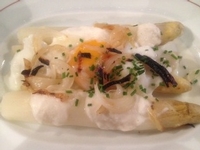 classic steak/frites. We were, and we went, and although the steak and fries were perfectly fine, what really made the meal a standout for me was the delectable asparagus I chose for my first course. Flawlessly fat and white, the spears were immersed in a delicate, foamy creaminess (“Cooked in milk,” said the server when I asked, but no further elaboration was forthcoming). A sprinkling of fried shallots over the top added extra pleasure, but the jewel in the crown was a poached egg which, when prodded with a fork, released its velvety, golden yolk over the asparagus like Hollandaise, only better. classic steak/frites. We were, and we went, and although the steak and fries were perfectly fine, what really made the meal a standout for me was the delectable asparagus I chose for my first course. Flawlessly fat and white, the spears were immersed in a delicate, foamy creaminess (“Cooked in milk,” said the server when I asked, but no further elaboration was forthcoming). A sprinkling of fried shallots over the top added extra pleasure, but the jewel in the crown was a poached egg which, when prodded with a fork, released its velvety, golden yolk over the asparagus like Hollandaise, only better.
PAUL BERT: 18 rue Paul Bert; 01 43 72 24 01
One noontime we joined Parisian friends for lunch in the 11th, at their current favorite eatery, Septime. This small, chicly unpretentious establishment, where every dish is a work of art for the eyes as well as the palate, is now among my own very top favorites. Are you surprised that I ordered asparagus for starters? At Septime the complex components mingling with the asparagus ranged from trout roe to translucently thin wafers of raw turnip. Although it might sound overly contrived, in fact, like the finest wine, this dish was intricate yet notable for its superb balance of tastes and textures. Lieu Jaune (an ocean fish translated as Pollock) was likewise complex, intermingling the delicate seafood with fennel fronds and fennel scented froth, smoked potatoes, and crispy fried chard leaves as bright and translucent as stained glass. This is cuisine that is new, fresh, and innovative yet impressively respectful of top quality ingredients. To put it mildly, I was dazzled.
SEPTIME: 8 rue de Charonne; 01 43 67 38 29
Les Fines Gueules, a charming bistrot/wine bar in the 1st housed in an historic 17th century building (designed by the acclaimed Jules Hardouin Mansart) was our destination for our last dinner in Paris. This bistro specializes in the type of comforting, fresh, gorgeous food that makes you take a bite, put down your fork, and begin purring. There is cool, creamy, springtime pea soup. Avocado tartare with crab. Veal carpaccio. A mountain of impeccably fresh and creamy Burrata topped with thinly sliced prosciutto. Beef tartare. We taste, we swallow, we look at each other and roll our eyes with pleasure.
On our way out the door at the end of the evening we overhear happy diners at the next table raving about Fine Gueules’ sister restaurant named A la Marguerite. Zut alors! If only we’d known about it earlier in the week, but now we won’t be able to eat there since we’re leaving Paris the following morning. But as the old song goes: “I love Paris in the springtime. I love Paris in the fall…I love Paris in the winter, when it drizzles…and the summer, when it sizzles.” There’s no doubt we’ll be back as soon as possible.
LES FINES GUEULES: 43 rue Croix des Petits Champs; 01 42 61 35 41
Posted by Marguerite Thomas at 2:05 PM
|
|
June 1, 2012
I’ve been writing about wine for 19 years and have managed to weasel my way into virtually every wine producing country of consequence. Uruguay was not quite The Final Frontier--to quote Captain Kirk--but it was among the handful of countries yet to stamp my passport, so 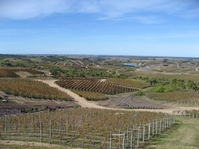 naturally I jumped at the chance to travel there last month for a week of tasting. naturally I jumped at the chance to travel there last month for a week of tasting.
If you are the type of reader who tries to sniff out a subtext from an introduction, you could be thinking at this point, “Okay, so Franz went to Uruguay as a sort of mopping-up operation for the sake of being thorough, just to be sure that a seemingly third-rate wine country isn’t actually second-rate instead, and now he’s going to deliver a lengthy, damning-by-faint-praise account that basically says that Uruguay has “potential.”
That would be a reasonable guess on your part, but it would be wrong. The upshot about wine from Uruguay is not a matter of “potential” or “promise” but rather of excellence. This excellence is an accomplished fact, and moreover it is an excellence in a distinctive mode--which is a separate point that is as important as the finding of excellence itself.
Uruguay’s wines bear little resemblance to those of Argentina or Chile. They display a stylistic profile all their own, and it is a first-rate profile incorporating moderate ripeness and fresh acidity (as in European wines) but generous fruit and relatively soft structure, as in New World 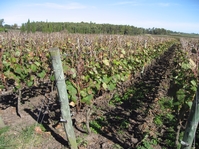 wines. Uruguay is home to a truly distinctive terroir that leaves a deeply etched signature on its wines, both white and red, consequently they are as interesting as they are delicious. wines. Uruguay is home to a truly distinctive terroir that leaves a deeply etched signature on its wines, both white and red, consequently they are as interesting as they are delicious.
How cool is that? Pretty damned cool, and I’ll have a good deal more to say about Uruguay’s wines in my column here on WRO next week. “Uruguay?” was a question posed by two intelligent and well-informed friends from the wine trade when learning of my whereabouts last month, and they’ll get my answer next Wednesday: Uruguay!
Posted by Michael Franz at 12:15 PM
|
|
 |
|